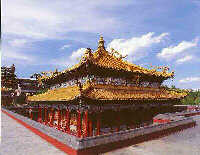The Temple of Sumeru Happiness and Longevity is located among the mountains to the north of the Mountain Resort in Chengde city, Hebei Province.
 The temple was first built in the 45th year(1780)of Emperor Qianlong's reign, and is one of the famous Outer Eight Temples in Chengde city, Hebei Province. Because of the 70th birthday of Emperor Qianlong, the 6th Panchen Erdeni traveled a long way to Chengde. Emperor Qianlong ordered to build an imperial palace for his short stay. The palace followed the model of Tashilunpo Monastery in Xigaze where the Sixth Panchen Lama lived. Tashilunpo meant happiness, longevity and auspicious in Tibetan language, while Sumeru meant mountain, and therefore the temple was so named, and generally called Large Imperial Palace.
The temple was first built in the 45th year(1780)of Emperor Qianlong's reign, and is one of the famous Outer Eight Temples in Chengde city, Hebei Province. Because of the 70th birthday of Emperor Qianlong, the 6th Panchen Erdeni traveled a long way to Chengde. Emperor Qianlong ordered to build an imperial palace for his short stay. The palace followed the model of Tashilunpo Monastery in Xigaze where the Sixth Panchen Lama lived. Tashilunpo meant happiness, longevity and auspicious in Tibetan language, while Sumeru meant mountain, and therefore the temple was so named, and generally called Large Imperial Palace.
The temple is divided into three parts: the middle, the front and the back. The front part consists of the Temple Gate, the Five-Hole Bridge, the Stele Pavilion, the Stone Lion, and the White Platform, etc; the main building in the middle part is a big three-storeyed red platform, on four corners of which each is built a small hall surrounded by walls. In the middle of the red platform is the Hall of Divinity and Solemn with pointed double-eave roof covered with fine gold bronze tiles looking like fish scales, on the ridge of which stand eight copper gold dragons, soaring into the sky and appearing grand and magnificent. There are statues of Sakyamuni and Arhats worshiped in the hall. On the west of the platform is the Wanfa Zongyuan Hall, which was the bedroom of the Panchen Lama. The Jinhe Hall in the back was the domicile for the pupils. There is a colorful and gorgeous Multi-Colored Glazed Pagoda in the backmost part of the temple. The seven-floored pagoda, appearing octagonal, towers aloft on the top of the mountain, which is the symbol of the Temple of Sumeru Happiness and Longevity.
The temple was the place where the Panchen Lama lived and expounded sutras. In the second year after the completion, the Qing government selected and sent 180 lamas from the upcountry to study the Tibetan sutras. And more than 50 lamas of Manchu ethnic minority spent 18 years on the translation of three volumes of Tibetan sutras in Manchu language, which are all lost today. The Temple of Sumeru Happiness and Longevity has played an important role in not only strengthening relationship between the central government and the local regime of Tibet, but also consolidating the unity of the multinational country.
